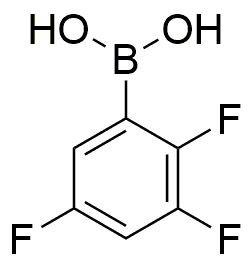2,3,5-Trifluorophenylboronic acid is widely utilized in research focused on:
- Organic Synthesis: This compound serves as a key building block in the synthesis of various organic molecules, particularly in the development of pharmaceuticals and agrochemicals, enhancing the efficiency of chemical reactions.
- Drug Development: Its unique properties allow for the modification of drug candidates, improving their efficacy and selectivity, which is crucial in the pharmaceutical industry for creating more effective treatments.
- Materials Science: Used in the fabrication of advanced materials, it contributes to the development of polymers and coatings with enhanced properties, such as increased durability and resistance to environmental factors.
- Bioconjugation: This compound is valuable in bioconjugation processes, where it helps attach biomolecules to surfaces or other molecules, facilitating research in biotechnology and diagnostics.
- Fluorine Chemistry: Its trifluoromethyl group provides unique reactivity, making it a useful tool in fluorine chemistry, which is essential for creating compounds with improved biological activity and stability.
General Information
Properties
Safety and Regulations
Applications
2,3,5-Trifluorophenylboronic acid is widely utilized in research focused on:
- Organic Synthesis: This compound serves as a key building block in the synthesis of various organic molecules, particularly in the development of pharmaceuticals and agrochemicals, enhancing the efficiency of chemical reactions.
- Drug Development: Its unique properties allow for the modification of drug candidates, improving their efficacy and selectivity, which is crucial in the pharmaceutical industry for creating more effective treatments.
- Materials Science: Used in the fabrication of advanced materials, it contributes to the development of polymers and coatings with enhanced properties, such as increased durability and resistance to environmental factors.
- Bioconjugation: This compound is valuable in bioconjugation processes, where it helps attach biomolecules to surfaces or other molecules, facilitating research in biotechnology and diagnostics.
- Fluorine Chemistry: Its trifluoromethyl group provides unique reactivity, making it a useful tool in fluorine chemistry, which is essential for creating compounds with improved biological activity and stability.
Documents
Safety Data Sheets (SDS)
The SDS provides comprehensive safety information on handling, storage, and disposal of the product.
Product Specification (PS)
The PS provides a comprehensive breakdown of the product’s properties, including chemical composition, physical state, purity, and storage requirements. It also details acceptable quality ranges and the product's intended applications.
Certificates of Analysis (COA)
Search for Certificates of Analysis (COA) by entering the products Lot Number. Lot and Batch Numbers can be found on a product’s label following the words ‘Lot’ or ‘Batch’.
*Catalog Number
*Lot Number
Certificates Of Origin (COO)
This COO confirms the country where the product was manufactured, and also details the materials and components used in it and whether it is derived from natural, synthetic, or other specific sources. This certificate may be required for customs, trade, and regulatory compliance.
*Catalog Number
*Lot Number
Safety Data Sheets (SDS)
The SDS provides comprehensive safety information on handling, storage, and disposal of the product.
DownloadProduct Specification (PS)
The PS provides a comprehensive breakdown of the product’s properties, including chemical composition, physical state, purity, and storage requirements. It also details acceptable quality ranges and the product's intended applications.
DownloadCertificates of Analysis (COA)
Search for Certificates of Analysis (COA) by entering the products Lot Number. Lot and Batch Numbers can be found on a product’s label following the words ‘Lot’ or ‘Batch’.
*Catalog Number
*Lot Number
Certificates Of Origin (COO)
This COO confirms the country where the product was manufactured, and also details the materials and components used in it and whether it is derived from natural, synthetic, or other specific sources. This certificate may be required for customs, trade, and regulatory compliance.


